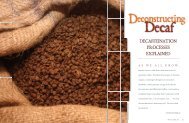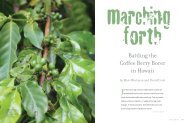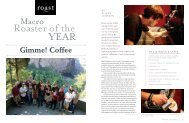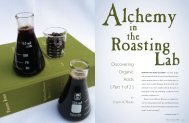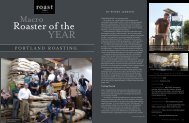Under the Microscope the science of browning ... - Roast Magazine
Under the Microscope the science of browning ... - Roast Magazine
Under the Microscope the science of browning ... - Roast Magazine
You also want an ePaper? Increase the reach of your titles
YUMPU automatically turns print PDFs into web optimized ePapers that Google loves.
<strong>Under</strong> <strong>the</strong> <strong>Microscope</strong><br />
<strong>the</strong> <strong>science</strong> <strong>of</strong> <strong>browning</strong> reactions<br />
Welcome BACK TO ANOTHER EDITION <strong>of</strong> <strong>Under</strong> <strong>the</strong> <strong>Microscope</strong>. In <strong>the</strong><br />
last issue we discussed <strong>the</strong> formation <strong>of</strong> acrylamide during <strong>the</strong> roasting<br />
process and briefly introduced <strong>the</strong> Maillard Reaction. This time around,<br />
we’ll take a deeper look at some <strong>of</strong> <strong>the</strong> o<strong>the</strong>r reactions taking place and<br />
discuss a new, complex set <strong>of</strong> reactions known collectively as <strong>browning</strong><br />
reactions. This new set <strong>of</strong> reactions affects not only c<strong>of</strong>fee but a broad<br />
range <strong>of</strong> food products and <strong>the</strong>ir flavor development. Although <strong>the</strong><br />
Maillard Reaction is considered one <strong>of</strong> <strong>the</strong> most important reactions<br />
to occur in food, it is only one <strong>of</strong> three <strong>browning</strong> reactions available to<br />
us. So, sit back and relax as we present to you <strong>the</strong> <strong>science</strong> <strong>of</strong> <strong>browning</strong><br />
reactions in this month’s lecture series.<br />
continued on page 44<br />
42 roast March | | April 2008 43 43<br />
Free Info #112
UNDER THE MICROSCOPE: <strong>browning</strong> REACTIONS (continued)<br />
Enzymatic Browning<br />
Unlike c<strong>of</strong>fee roasting, which requires high temperatures to<br />
initiate, enzymatic <strong>browning</strong> reactions occur spontaneously and<br />
at room temperature. However, like all reactions occurring in<br />
nature, a source <strong>of</strong> energy is required for initial activation. In <strong>the</strong><br />
case <strong>of</strong> c<strong>of</strong>fee, <strong>the</strong> activation energy is provided by <strong>the</strong> heat created<br />
by roasters, but enzymatic reactions require <strong>the</strong> presence <strong>of</strong> a<br />
specific catalyst, or enzyme. Simply put, an enzyme is a unique<br />
protein that accelerates specific reactions. There are literally<br />
thousands <strong>of</strong> enzymes in biological systems, and without <strong>the</strong>m<br />
life would come to a grinding halt. The alcohol contained in<br />
those glasses <strong>of</strong> wine we enjoyed this weekend was metabolized<br />
by none o<strong>the</strong>r than alcohol dehydrogenase, while <strong>the</strong> protein<br />
in our steak was broken down into smaller, more digestible<br />
fragments by pepsin—a stomach enzyme. And <strong>the</strong> caffeine that<br />
we so religiously consume every day is metabolized by a broad<br />
range <strong>of</strong> important co-enzymes called Cytochrome P450.<br />
Although <strong>the</strong> technical name may be elusive, enzymatic<br />
<strong>browning</strong> is a phenomenon that we’ve all experienced firsthand.<br />
The reaction is best illustrated by taking a fresh apple and<br />
slicing it in half. As we cut through <strong>the</strong> apple’s cellulose tissue,<br />
cells rupture, <strong>the</strong>reby releasing a myriad <strong>of</strong> compounds into<br />
surrounding tissue. One important compound is an enzyme<br />
called polyphenol oxidase (PPO). Once exposed to air, <strong>the</strong> enzyme<br />
rapidly transforms colorless phenols present in <strong>the</strong> apple’s tissue<br />
into a long chain <strong>of</strong> brown-colored polymeric compounds—and<br />
ultimately ruins our pristine white apple. Although <strong>the</strong> brownish<br />
hue may be unappealing to <strong>the</strong> eye, contrary to popular belief, <strong>the</strong><br />
reaction in no way creates toxins or endangers <strong>the</strong> health <strong>of</strong> those<br />
consuming it—as long as you’re not bacteria.<br />
Just like a Russian KGB agent carries a pill <strong>of</strong> lethal cyanide<br />
with him (in <strong>the</strong> event <strong>of</strong> capture by enemies), <strong>the</strong> apple senses<br />
when it’s been attacked and immediately jumps into self-defense<br />
mode. But, how? By creating <strong>the</strong> very same brown polymers we<br />
discussed. According to researchers, <strong>the</strong> brown polymer created<br />
during enzymatic <strong>browning</strong> is highly toxic to bacteria. It’s Mo<strong>the</strong>r<br />
Nature’s way <strong>of</strong> protecting <strong>the</strong> plant from bacterial infection<br />
during its latter, more vulnerable stages <strong>of</strong> ripening.<br />
Though <strong>the</strong> benefits <strong>of</strong> enzymatic <strong>browning</strong> remain<br />
Scientists have developed<br />
limited to only a handful <strong>of</strong> products such as raisins, plums,<br />
figs and cacao, <strong>the</strong> reaction is, for <strong>the</strong> most part, a detriment<br />
relatively simple ways <strong>of</strong><br />
and serious quality concern. Because <strong>of</strong> its spontaneous<br />
nature, enzymatic <strong>browning</strong> represents a significant economic<br />
inactivating enzymes and<br />
loss within <strong>the</strong> fruit and vegetable industry. It’s been<br />
estimated that at least 50 percent <strong>of</strong> all fruit and vegetable<br />
mitigating <strong>browning</strong> losses.<br />
goods are damaged due to bruising/tearing during transport<br />
to market. As such, scientists have developed relatively simple<br />
ways <strong>of</strong> inactivating enzymes and mitigating <strong>browning</strong> losses.<br />
Blanching, or essentially steaming, is useful as <strong>the</strong> heat<br />
without it. For now, think <strong>of</strong> enzymatic reactions as <strong>the</strong> boring<br />
deactivates PPO and prevents <strong>browning</strong>. Unfortunately, not<br />
sibling <strong>of</strong> <strong>browning</strong> reactions. And for <strong>the</strong> typical caffeine-junkie<br />
all products can be subject to this. Ano<strong>the</strong>r method involves<br />
roasters, that’s not enough—we need more spark and complexity!<br />
<strong>the</strong> addition <strong>of</strong> an acid, usually ascorbic acid, to <strong>the</strong> preoxidized<br />
product. Many chefs, for example, add a bit <strong>of</strong> lime<br />
This is where we begin our next discussion <strong>of</strong> non-enzymatic<br />
reactions. This next set <strong>of</strong> complex reactions will serve to explain<br />
juice to fresh guacamole during preparation. Turns out that<br />
<strong>the</strong> bulk <strong>of</strong> <strong>the</strong> chemical changes occurring in c<strong>of</strong>fee during<br />
<strong>the</strong> decrease in pH prevent <strong>the</strong> phenols from oxidizing and<br />
roasting.<br />
thus prevent, or at least delay, enzymatic <strong>browning</strong>.<br />
So with all this talk about enzymatic reactions you’re<br />
probably wondering at this point, “So how does this relate Non-Enzymatic Browning<br />
to c<strong>of</strong>fee?” Well, it doesn’t. Sorry. Enzymatic reactions are<br />
only important for products such as tea and cocoa, which Unlike <strong>the</strong> enzymatic reactions we discussed earlier, non-enzymatic<br />
during post-processing serve to create flavor changes. We reactions are significantly different. In <strong>the</strong> latter, no enzyme is<br />
only mention enzymatic reactions as a formality, since any required, but <strong>the</strong> reaction does require <strong>the</strong> presence <strong>of</strong> heat, sugar<br />
discussion on <strong>browning</strong> reactions would be incomplete continued on page 46<br />
Free Info #145 Free Info #125<br />
Free Info #138<br />
44 roast March | April 2008 45
UNDER THE MICROSCOPE: <strong>browning</strong> REACTIONS (continued)<br />
and amino acids. As we’ll discuss in<br />
greater detail, two <strong>of</strong> <strong>the</strong> most important<br />
non-enzymatic reactions in c<strong>of</strong>fee are<br />
caramelization and <strong>the</strong> Maillard reaction.<br />
Caramelization<br />
Caramelization is perhaps <strong>the</strong> easier<br />
<strong>of</strong> <strong>the</strong> two non-enzymatic <strong>browning</strong><br />
reactions to describe. Simply put,<br />
caramelization is <strong>the</strong> oxidation or <strong>the</strong><br />
<strong>the</strong>rmal decomposition <strong>of</strong> sugars into<br />
color and flavors. Although any sugar can<br />
be caramelized, we typically see sucrose,<br />
or table sugar, as <strong>the</strong> sugar <strong>of</strong> choice<br />
for cooking applications. As sucrose is<br />
heated to 160° C it slowly begins to melt,<br />
losing water molecules in <strong>the</strong> process<br />
and becoming a viscous semi-transparent<br />
liquid. As heating reaches 200° C, <strong>the</strong><br />
compounds in <strong>the</strong> molten sugar begin<br />
to rearrange, forming brown-colored<br />
caramel-like compounds and imparting<br />
its characteristic burnt caramel aroma.<br />
But this isn’t your grandpa’s caramel;<br />
<strong>the</strong> caramel created in this process is<br />
unlike <strong>the</strong> caramel candy we all loved<br />
as kids. This caramel is a bitter/burnt<br />
gooey compound with little to no<br />
sweetness, occasionally used as <strong>the</strong><br />
topping on custard desserts. The<br />
caramel we eat is created by mixing<br />
sugar, milk and o<strong>the</strong>r flavorings, but it is<br />
produced in much <strong>the</strong> same manner as<br />
<strong>the</strong> caramel that occurs in c<strong>of</strong>fee.<br />
Depending on <strong>the</strong> heating<br />
conditions, manufacturers can shift<br />
<strong>the</strong> by-products <strong>of</strong> caramelization<br />
to ei<strong>the</strong>r maximize <strong>the</strong> formation<br />
<strong>of</strong> aromatic compounds or colored<br />
caramel-like compounds. In <strong>the</strong><br />
latter condition, sugar is heated in<br />
<strong>the</strong> presence <strong>of</strong> ammonia to produce<br />
high concentrations <strong>of</strong> brown-colored<br />
compounds, typically used by <strong>the</strong> cola<br />
industry for coloring.<br />
In addition to creating aroma<br />
and color, caramelization creates a<br />
broad range <strong>of</strong> compounds including<br />
organic acids in <strong>the</strong> process. We can<br />
clearly see this, for example, in <strong>the</strong><br />
making <strong>of</strong> peanut brittle. In <strong>the</strong> latter<br />
stages <strong>of</strong> commercial brittle making,<br />
caramelized sugar is allowed to cool<br />
and thicken, at which time baking<br />
soda and o<strong>the</strong>r flavorings are usually<br />
added. The baking soda <strong>the</strong>n reacts<br />
with <strong>the</strong> organic acids produced during<br />
caramelization, neutralizing <strong>the</strong>m to<br />
form carbon dioxide gas. This gas acts<br />
as a leavening agent, creating tunnels in<br />
<strong>the</strong> product and ultimately producing<br />
<strong>the</strong> characteristic “Swiss cheese” texture<br />
commonly found in candy brittle.<br />
In c<strong>of</strong>fee, a similar reaction<br />
occurs. As sugar is decomposed, it too<br />
produces carbon dioxide gas, which<br />
increases cell pressure within <strong>the</strong> bean,<br />
rupturing it and, ultimately, producing<br />
<strong>the</strong> audible “pop” we hear during<br />
second crack. What about first crack?<br />
Well, technically, <strong>the</strong> first crack is<br />
produced, partly, by <strong>the</strong> rapid increase<br />
in cell pressure by evaporating water—<br />
steam—during <strong>the</strong> roasting process.<br />
Up to 90 percent <strong>of</strong> <strong>the</strong> initial<br />
sucrose is decomposed during roasting<br />
to produce a wide range <strong>of</strong> byproducts,<br />
including formic and acetic acid.<br />
Studies have shown that acetic acid<br />
concentration in model studies can<br />
increase up to twenty times its initial<br />
concentration, namely in <strong>the</strong> early part<br />
<strong>of</strong> roasting, <strong>the</strong>n quickly evaporating<br />
in latter stages—due to its volatility.<br />
But acetic acid is unique in that it is<br />
a relatively weak acid, which affects<br />
perceived acidity and overall c<strong>of</strong>fee<br />
quality. It’s no surprise <strong>the</strong>n, that with<br />
arabica containing almost twice <strong>the</strong><br />
concentration <strong>of</strong> sucrose as robusta, we<br />
perceive a greater intensity <strong>of</strong> aroma and<br />
acidity in <strong>the</strong> cup.<br />
In summary, caramelization serves<br />
to create color, aroma, acids and carbon<br />
dioxide during <strong>the</strong> roasting process.<br />
Since both caramelization and <strong>the</strong><br />
Maillard reaction (discussed next) occur<br />
at different temperatures, what we<br />
ultimately get after roasting is a product<br />
that has by-products <strong>of</strong> both.<br />
The Maillard Reaction<br />
Of all <strong>the</strong> reactions discussed so far,<br />
<strong>the</strong> Maillard reaction is perhaps <strong>the</strong><br />
godfa<strong>the</strong>r <strong>of</strong> all <strong>browning</strong> reactions.<br />
Though <strong>the</strong> reaction is typically<br />
associated with food, its true origin is<br />
actually deeply rooted in <strong>the</strong> medical<br />
field. In 1900, Dr. Louis Camille<br />
Maillard embarked on solving one <strong>of</strong><br />
life’s most complex questions: how does<br />
<strong>the</strong> human body create proteins? His<br />
early attempts to solve this involved<br />
combining isolated amino acids in vials<br />
and agitating, with no luck. When he<br />
combined reducing sugars (glucose) and<br />
subjected <strong>the</strong> same amino acid mixture<br />
to heat, he was stunned. As heat was<br />
applied to <strong>the</strong> mixture, <strong>the</strong> solution<br />
slowly changed from a clear liquid to a<br />
brown solution, giving <strong>of</strong>f nutty/bready<br />
aromas—essentially marking <strong>the</strong><br />
discovery <strong>of</strong> <strong>the</strong> Maillard Reaction. Since<br />
<strong>the</strong>n, hundreds <strong>of</strong> manufacturers have<br />
tweaked <strong>the</strong> reaction, and it now serves<br />
as a source for aroma development<br />
within <strong>the</strong> food industry. But it wasn’t<br />
until after World War II—when soldiers<br />
complained that <strong>the</strong>ir powdered eggs<br />
were changing color and producing<br />
<strong>of</strong>f-flavors—that <strong>the</strong> military seriously<br />
began to study <strong>the</strong> reaction in detail.<br />
Fifty years later, we’re still unlocking <strong>the</strong><br />
mystery <strong>of</strong> this complex reaction. Though<br />
<strong>the</strong> reaction still plays an important role<br />
in food, in recent years it’s also become a<br />
topic <strong>of</strong> great interest in <strong>the</strong> medical field<br />
since it’s believed to be involved in <strong>the</strong><br />
aging process.<br />
In essence, <strong>the</strong> Maillard reaction is<br />
Free Info #124 Free Info #148<br />
<strong>the</strong> process whereby available amino<br />
acids and sugars combine in <strong>the</strong>rmally<br />
processed food. We’ll discuss details later,<br />
but it’s essentially <strong>the</strong> reaction responsible<br />
for producing <strong>the</strong> aroma and flavor in<br />
products such as toasted bread, steak<br />
and c<strong>of</strong>fee. Its been estimated that in<br />
steak and c<strong>of</strong>fee alone, more than 600<br />
continued on page 48<br />
46 roast March | April 2008 47
UNDER THE MICROSCOPE: <strong>browning</strong> REACTIONS (continued)<br />
• Simplified Outline <strong>of</strong> The Maillard Reaction<br />
N-glucosamine<br />
*several detailed steps omitted for simplicity<br />
compounds combine to create <strong>the</strong>ir complex aroma. And though<br />
extremely complex, what we’ll discuss next is simply a layman’s<br />
Getting a Reaction<br />
introduction to <strong>the</strong> Maillard reaction, as a comprehensive<br />
INTERESTINGLY, <strong>the</strong> Maillard reaction does not<br />
explanation would be outside <strong>the</strong> scope <strong>of</strong> this article.<br />
always require heat to initiate. To see one example <strong>of</strong><br />
In a nutshell, <strong>the</strong> Maillard reaction can be summarized in<br />
this, we need to go no fur<strong>the</strong>r than our local beach.<br />
four major steps: In step one, amino acids combine with sugars<br />
That’s right, it turns out that much <strong>of</strong> <strong>the</strong> same<br />
to form several N-glucosamine compounds during roasting.<br />
chemistry that is involved in <strong>the</strong> Maillard reaction is<br />
Since <strong>the</strong>se compounds are relatively unstable, <strong>the</strong>y typically<br />
actually used in <strong>the</strong> production <strong>of</strong> self-tanning creams.<br />
undergo a second set <strong>of</strong> reactions—Amadori or Heynes—to form<br />
Though <strong>the</strong>se creams don’t produce a “real” tan, <strong>the</strong>y<br />
several o<strong>the</strong>r intermediates (step two). Up until this point, all<br />
do provide enough brown-colored pigment under <strong>the</strong><br />
<strong>the</strong> compounds produced are colorless and lack any detectable<br />
skin to impress a few beachgoers. Who could imagine<br />
flavor. But it’s not until we reach step three, or <strong>the</strong> Strecker<br />
that <strong>the</strong> same reactions that occur during c<strong>of</strong>fee<br />
degradation, where a handful <strong>of</strong> N-glucosamine (those with<br />
roasting are <strong>the</strong> same ones to occur at <strong>the</strong> beach<br />
double bonds created in step one) react with o<strong>the</strong>r amino acids<br />
every day, and on that stunning blonde sporting a<br />
to form compounds we typically associate with c<strong>of</strong>fee aroma.<br />
bikini? Career change, please!<br />
Pyrazines and pyridines, which typically have maize/nutty/bitter<br />
aromas, and many o<strong>the</strong>r compounds are produced in this step.<br />
And finally, in step four, all remaining intermediates combine to<br />
form long chains <strong>of</strong> brown-colored melanoidins—<strong>the</strong> compound eggs, which already have a low water activity, <strong>browning</strong> occurs<br />
responsible for a c<strong>of</strong>fee’s color.<br />
much more quickly. Also, <strong>the</strong> reaction accelerates in alkaline<br />
There are a number <strong>of</strong> factors that affect <strong>the</strong> Maillard<br />
environments (pH greater than 7) and varies with <strong>the</strong> type <strong>of</strong><br />
reaction, including moisture level, pH and temperature. Since sugar and amino acid present. Though some <strong>of</strong> <strong>the</strong>se factors may<br />
water is produced in <strong>the</strong> combination <strong>of</strong> amino acids with sugars, be out <strong>of</strong> our immediate control, <strong>the</strong> one thing we can control is<br />
products with excess water activity actually impede <strong>the</strong> reaction. temperature. According to empirical data, it’s been shown that<br />
So for those products such as bread, powdered milk or powdered continued on page 50<br />
Free Info #143 Free Info #144<br />
Free Info #108<br />
Free Info #139<br />
48 roast March | April 2008 49
UNDER THE MICROSCOPE: <strong>browning</strong> REACTIONS (continued)<br />
<strong>the</strong> Maillard Reaction doubles for every 10-degree increase in<br />
temperature. Interesting, but anyone who has ever taken a roast<br />
past second crack can easily attest to this. Why?<br />
Here’s <strong>the</strong> technical scoop: As <strong>the</strong> bean enters deeper roasting<br />
Peak Heights<br />
20<br />
Pyridine PyrAZINE<br />
10<br />
0<br />
7 8 9 10 11 12<br />
<strong>Roast</strong>ing time (min)<br />
<strong>Roast</strong>ing time (min)<br />
stages, more and more water is driven out <strong>of</strong> <strong>the</strong> bean, <strong>the</strong>reby<br />
increasing <strong>the</strong> concentration <strong>of</strong> potential reactants (much<br />
like when water evaporates in <strong>the</strong> ocean, increasing <strong>the</strong> salt<br />
concentration) and allowing more reactions to occur. Also, as<br />
Phenol<br />
<strong>Roast</strong>ing time (min)<br />
Acetic<br />
Acid<br />
7 8 9 10 11 12 7 8 9 10 11 12 7 8 9 10 11 12<br />
• graph <strong>of</strong> flavor changes during roasting<br />
<strong>Roast</strong>ing time (min)<br />
temperatures elevate and changes in composition occur, several<br />
variables react to generate <strong>the</strong> flavor trends shown in <strong>the</strong> graph.<br />
We can see that as roasting progresses, a significant increase in<br />
<strong>the</strong> levels <strong>of</strong> pyrazine, phenols and pyridines is produced. Acetic<br />
acid increases in <strong>the</strong> early part <strong>of</strong> <strong>the</strong> roast, reaching a peak,<br />
<strong>the</strong>n rapidly diminishing due to its volatility. There are literally<br />
hundreds <strong>of</strong> o<strong>the</strong>r reactions taking place simultaneously, but in<br />
<strong>the</strong> end, what does all this mean? It basically explains why we see<br />
a general increase in <strong>the</strong> level <strong>of</strong> aroma, body and astringency and<br />
a muting <strong>of</strong> acidity in darker roasted c<strong>of</strong>fees.<br />
So at this point you’re probably wondering: “Is <strong>the</strong>re a<br />
difference between caramelization and <strong>the</strong> Maillard reaction?<br />
They sound similar.” It’s true, <strong>the</strong>y do sound <strong>the</strong> same, but <strong>the</strong>y<br />
aren’t quite. Here’s a recap:<br />
• Caramelization does not require a nitrogen source.<br />
Remember, caramelization is simply a decomposition <strong>of</strong> sugar.<br />
This is unlike <strong>the</strong> Maillard reaction, which requires sugar and<br />
amino acid (nitrogen source).<br />
• Caramelization occurs at much higher temperatures than<br />
<strong>the</strong> Maillard reaction. The Maillard reaction can occur at room<br />
temperature, albeit very slowly, while caramelization typically<br />
requires much higher temperatures (over 150°C).<br />
• Both reactions form melanoidins and flavor compounds.<br />
Although caramelization and <strong>the</strong> Maillard reaction follow<br />
different paths, we essentially end up with <strong>the</strong> same type <strong>of</strong> end<br />
products—color and flavor.<br />
Thus far, we’ve only skimmed <strong>the</strong> surface in attempting to<br />
explain <strong>the</strong> chemistry behind c<strong>of</strong>fee roasting. Though I’m sure<br />
many people now have more questions than answers, we hope<br />
that <strong>the</strong> material presented in this month’s series will serve as a<br />
good starting point for fur<strong>the</strong>r study. In <strong>the</strong> next issue, we’ll see<br />
how much <strong>of</strong> <strong>the</strong>se flavor compounds created actually end up in<br />
our cup.<br />
Joseph A. Rivera is <strong>the</strong> director <strong>of</strong> <strong>science</strong> and technology at <strong>the</strong><br />
Specialty C<strong>of</strong>fee Association <strong>of</strong> America (SCAA) and founder <strong>of</strong> <strong>the</strong><br />
c<strong>of</strong>fee <strong>science</strong> website, www.c<strong>of</strong>feechemistry.com. He can be reached<br />
at jrivera@c<strong>of</strong>feechemistry.com.<br />
Let’s Review!<br />
(we told you <strong>the</strong>re’d be a quiz, didn’t we?)<br />
> What enzyme is responsible for <strong>the</strong> <strong>browning</strong> in<br />
fruits such as apples and bananas?<br />
> What factors affect <strong>the</strong> Maillard reaction?<br />
> What is <strong>the</strong> difference between caramelization and<br />
<strong>the</strong> Maillard reaction?<br />
Free Info #108 Free Info #146<br />
Free Info #147<br />
50 roast March | April 2008 51





